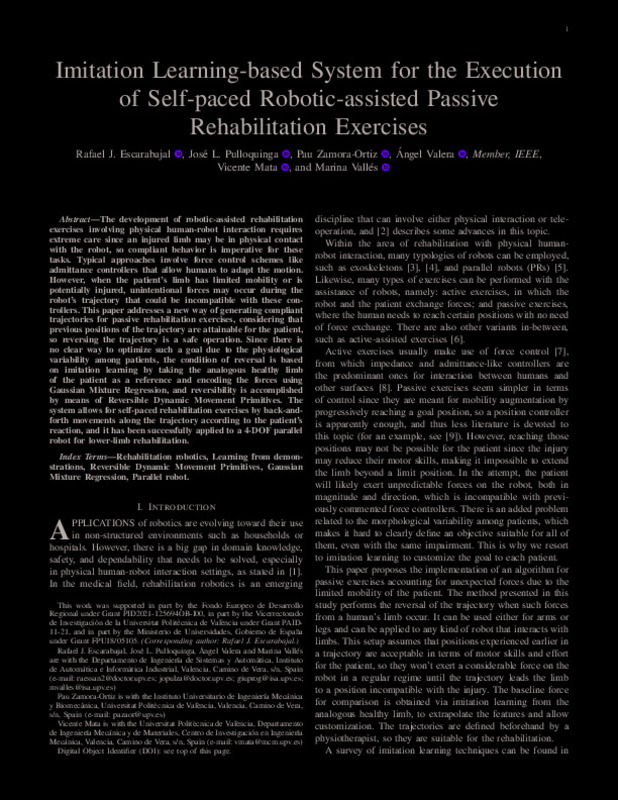JavaScript is disabled for your browser. Some features of this site may not work without it.
Buscar en RiuNet
Listar
Mi cuenta
Estadísticas
Ayuda RiuNet
Admin. UPV
Imitation Learning-Based System for the Execution of Self-Paced Robotic-Assisted Passive Rehabilitation Exercises
Mostrar el registro sencillo del ítem
Ficheros en el ítem
| dc.contributor.author | Escarabajal-Sánchez, Rafael José
|
es_ES |
| dc.contributor.author | Pulloquinga-Zapata, José
|
es_ES |
| dc.contributor.author | Zamora-Ortiz, Pau
|
es_ES |
| dc.contributor.author | Valera Fernández, Ángel
|
es_ES |
| dc.contributor.author | Mata Amela, Vicente
|
es_ES |
| dc.contributor.author | Vallés Miquel, Marina
|
es_ES |
| dc.date.accessioned | 2024-01-10T19:03:17Z | |
| dc.date.available | 2024-01-10T19:03:17Z | |
| dc.date.issued | 2023-07 | es_ES |
| dc.identifier.uri | http://hdl.handle.net/10251/201738 | |
| dc.description.abstract | [EN] The development of robotic-assisted rehabilitation exercises involving physical human-robot interaction requires extreme care since an injured limb may be in physical contact with the robot, so compliant behavior is imperative for these tasks. Typical approaches involve force control schemes like admittance controllers that allow humans to adapt the motion. However, when the patient¿s limb has limited mobility or is potentially injured, unintentional forces may occur during the robot¿s trajectory that could be incompatible with these controllers. This letter addresses a new way of generating compliant trajectories for passive rehabilitation exercises, considering that previous positions of the trajectory are attainable for the patient, so reversing the trajectory is a safe op eration. Since there is no clear way to optimize such a goal due to the physiological variability among patients, the condition of reversal is based on imitation learning by taking the analogous healthy limb of the patient as a reference and encoding the forces using Gaussian Mixture Regression, and reversibility is accomplished by means of Reversible Dynamic Movement Primitives. The system allows for self-paced rehabilitation exercises by back-and-forth movements along the trajectory according to the patient¿s reaction, and it has been successfully applied to a 4-DOF parallel robot for lower-limb rehabilitation. | es_ES |
| dc.description.sponsorship | This work was supported in part by the Fondo Europeo de Desarrollo Regional under Grant PID2021-125694OB-I00, in part by the Vicerrectorado de Investigación de la Universitat Politècnica de València under Grant PAID-11-21, and in part by the Ministerio de Universidades, Gobierno de España under Grant FPU18/05105 | es_ES |
| dc.language | Inglés | es_ES |
| dc.publisher | Institute of Electrical and Electronics Engineers | es_ES |
| dc.relation.ispartof | IEEE Robotics and Automation Letters | es_ES |
| dc.rights | Reserva de todos los derechos | es_ES |
| dc.subject | Rehabilitation robotics | es_ES |
| dc.subject | Learning from demonstrations | es_ES |
| dc.subject | Reversible dynamic movement primitives | es_ES |
| dc.subject | Gaussian mixture regression | es_ES |
| dc.subject | Parallel robot | es_ES |
| dc.subject.classification | INGENIERIA DE SISTEMAS Y AUTOMATICA | es_ES |
| dc.subject.classification | INGENIERIA MECANICA | es_ES |
| dc.title | Imitation Learning-Based System for the Execution of Self-Paced Robotic-Assisted Passive Rehabilitation Exercises | es_ES |
| dc.type | Artículo | es_ES |
| dc.identifier.doi | 10.1109/LRA.2023.3281884 | es_ES |
| dc.relation.projectID | info:eu-repo/grantAgreement/AEI//PID2021-125694OB-I00//SISTEMA ROBÓTICO PARALELO CON CONTROL BASADO EN MODELO MÚSCULO-ESQUELÉTICO PARA LA MONITORIZACIÓN Y ENTRENAMIENTO DEL SISTEMA PROPIOCEPTIVO/ | es_ES |
| dc.relation.projectID | info:eu-repo/grantAgreement/UPV-VIN//AYUDA PAID-11-21//Parallel rehabilitation robots: detection and control of singularities in the presence of manufacturing errors/ | es_ES |
| dc.relation.projectID | info:eu-repo/grantAgreement/ //FPU18%2F05105//AYUDA PREDOCTORAL FPU-ESCARABAJAL SANCHEZ. PROYECTO: DESARROLLO Y CONTROL DE ROBOTS PARALELOS RECONFIGURABLES PARA LA REHABILITACIÓN DE MIEMBRO INFERIOR DE PERSONAS/ | es_ES |
| dc.rights.accessRights | Abierto | es_ES |
| dc.contributor.affiliation | Universitat Politècnica de València. Escuela Técnica Superior de Ingenieros Industriales - Escola Tècnica Superior d'Enginyers Industrials | es_ES |
| dc.contributor.affiliation | Universitat Politècnica de València. Escola Tècnica Superior d'Enginyeria Informàtica | es_ES |
| dc.contributor.affiliation | Universitat Politècnica de València. Departamento de Ingeniería de Sistemas y Automática - Departament d'Enginyeria de Sistemes i Automàtica | es_ES |
| dc.contributor.affiliation | Universitat Politècnica de València. Escuela Técnica Superior de Ingeniería del Diseño - Escola Tècnica Superior d'Enginyeria del Disseny | es_ES |
| dc.contributor.affiliation | Universitat Politècnica de València. Departamento de Ingeniería Electrónica - Departament d'Enginyeria Electrònica | es_ES |
| dc.description.bibliographicCitation | Escarabajal-Sánchez, RJ.; Pulloquinga-Zapata, J.; Zamora-Ortiz, P.; Valera Fernández, Á.; Mata Amela, V.; Vallés Miquel, M. (2023). Imitation Learning-Based System for the Execution of Self-Paced Robotic-Assisted Passive Rehabilitation Exercises. IEEE Robotics and Automation Letters. 8(7):4283-4290. https://doi.org/10.1109/LRA.2023.3281884 | es_ES |
| dc.description.accrualMethod | S | es_ES |
| dc.relation.publisherversion | https://doi.org/10.1109/LRA.2023.3281884 | es_ES |
| dc.description.upvformatpinicio | 4283 | es_ES |
| dc.description.upvformatpfin | 4290 | es_ES |
| dc.type.version | info:eu-repo/semantics/publishedVersion | es_ES |
| dc.description.volume | 8 | es_ES |
| dc.description.issue | 7 | es_ES |
| dc.identifier.eissn | 2377-3766 | es_ES |
| dc.relation.pasarela | S\495396 | es_ES |
| dc.contributor.funder | AGENCIA ESTATAL DE INVESTIGACION | es_ES |
| dc.contributor.funder | MINISTERIO DE CIENCIA E INNOVACION | es_ES |
| dc.contributor.funder | UNIVERSIDAD POLITECNICA DE VALENCIA | es_ES |







![[Cerrado]](/themes/UPV/images/candado.png)

